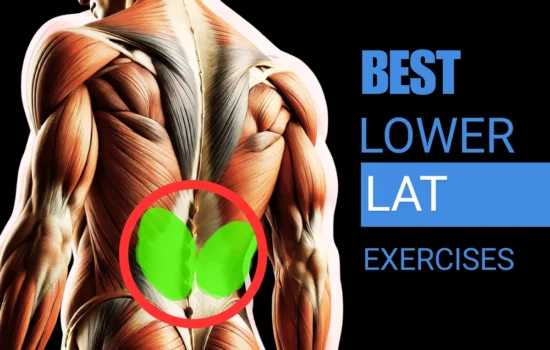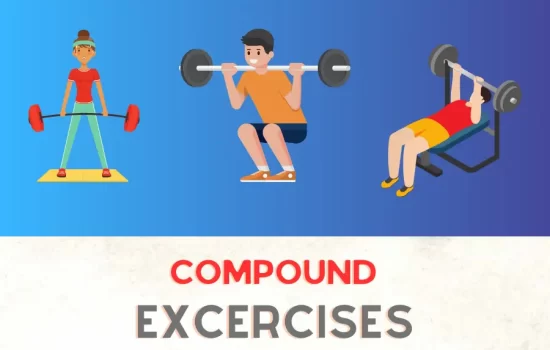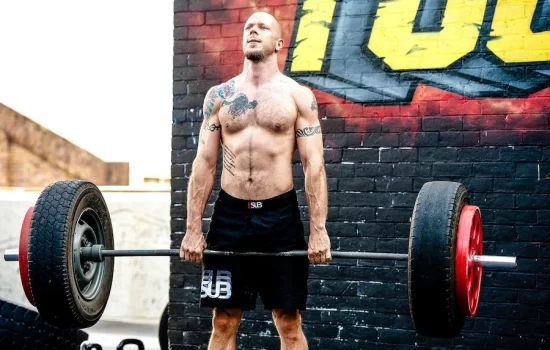Table of Contents
Building a strong, well-defined chest isn’t just about aesthetics. It is also about power, balance, and overall fitness. Whether you’re aiming for a bigger bench press or just want that full, rounded chest look, the right exercises can make all the difference. This article is designed with the chest workout that you’ll ever need. Basically, It covers 9 compound and 6 isolation chest exercises to help you achieve goals. Plus, we’ll explore when it’s best to use each type of exercise, so you get the most out of your chest workouts.
What Are Compound and Isolation Exercises?
Before diving into the exercises, let’s break down what compound and isolation exercises actually mean. Understanding these differences can guide you to better results and a more effective workout plan.
Compound Exercises: What Makes Them Special?
Compound exercises are multi-joint movements that target several muscle groups at once. When it comes to chest exercises, usually engage your shoulders, triceps, and even parts of your back. The beauty of compound movements lies in their efficiency you’re able to lift heavier weights, work multiple muscles, and build functional strength that can benefit everyday activities.
Examples of Compound Exercises are bench presses, push-ups, and dips.
Related: What is Compound Exercise?
Isolation Exercises: Precision and Focus
Isolation exercises, on the other hand, focus on one specific muscle group. For the chest, that means movements that target the pectorals without relying heavily on other muscles. Isolation exercises are excellent for addressing weak spots or achieving a muscle pump to enhance muscle growth.
Examples of Isolation Exercises are cable flies, chest flyes, and dumbbell pullovers.
When to Do Compound Versus Isolation Exercises?
Knowing when to incorporate compound or isolation exercises can make a world of difference in your training.
- Start with Compound Exercises: These should typically come first in your routine, as they require more energy and allow you to lift heavier weights. They are great for building overall strength.
- End with Isolation Exercises: After you’ve exhausted your chest with compound movements, isolation exercises are perfect for adding that final burn. They help to refine and define the muscles, ensuring no part is left underworked.
9 Best Compound Chest Exercises
Let’s start with some compound exercises that will help build your chest from the ground up. These exercises ensure that you hit all areas of the chest for a balanced and powerful look.
1. CHEST DIPS

Muscles Worked: Lower pectoralis major, triceps, anterior deltoids.
Chest dips is a compound chest workout that helps strengthen your chest, shoulders, and arms. it focuses particularly on the pectoralis major and also has impacts on the triceps and shoulders.
How to Do Chest Dips?
- Stand between two parallel bars, holding onto them with your hands.
- Lift your body by straightening your arms. This is your starting point.
- Slowly bend your elbows and lower your body until your shoulders are below your elbows or you feel a stretch in your chest.
- Push yourself back up by straightening your arms.
- Breathe in as you lower your body and breathe out as you lift yourself.
- Keep your body steady, avoid leaning too much, and make sure your elbows point a bit outward to engage your chest
- Repeat the reps as desired.
Injury Risk: Avoid going too deep to prevent shoulder strain.
Pro Tip: Leaning forward targets the chest more, while a more upright position focuses on the triceps. And your elbows tucked in to avoid putting strain on the shoulders
Check out the Video:
2. BARBELL BENCH PRESS
Muscles Worked: Pectoralis major (middle and lower), anterior deltoids, triceps.
The barbell bench press is a classic and effective strength training compound chest exercise that targets the muscles in your chest, shoulders, and triceps. It’s a straightforward yet powerful workout that involves lying on a flat bench and lifting a barbell loaded with weights above your chest.
How to Do Barbell Bench Press?
- To perform the barbell bench press, first, you need to lie down on the flat bench with your feet placed on either side.
- Grab the barbell with hands slightly wider than shoulder-width apart, and lower it to your chest level.
- Then push it up and bring it back up to the starting position.
- Maintain your hold on the bar and lower it until your elbows are in line with the floor and at chest level.
- You just did a rep of Barbell Bench Press
- Now continue to do the exercise as much as you have planned and take a break before moving to the next one.
Injury Risk: Be cautious with heavy weights, as poor form can lead to shoulder injuries.
Pro Tip: Focus on squeezing your chest and keep your core tight at the top of each rep for maximum engagement.
Check out the Video:
3. DUMBBELL BENCH PRESS

The dumbbell bench press offers a greater range of motion compared to the barbell press, which can lead to better muscle activation. It’s also an excellent option for evening out muscle imbalances, as each arm works independently.
Muscles Worked: Pectoralis major, anterior deltoids, triceps.
How to Do Dumbell Bench Press?
- Lie back on a flat bench, holding a dumbbell in each hand.
- Press the dumbbells directly above your chest.
- Lower the weights slowly until your elbows are at a 90-degree angle.
- Push the dumbbells back up to the starting position.
Injury Risk: Control the weights on the way down to prevent strain on the shoulder joints.
Pro Tip: Rotate your wrists slightly inward at the top for a greater squeeze on the chest.
Checkout the Video:
4. INCLINE BARBBELL BENCH PRESS
The Incline Barbbell Bench Press is a variation of the traditional bench press that shifts the focus to the upper part of the chest. It helps build a fuller and more defined upper chest, giving your chest a more balanced appearance. This exercise also engages the shoulders and triceps, making it an excellent upper-body workout.
Muscles Worked: Upper chest, deltoids, triceps
Steps to do Incline Barbbell Bench Press
- Adjust the bench to a 30-45 degree incline.
- Lie back on the incline bench and grip the barbell slightly wider than shoulder-width apart.
- Lower the barbell slowly towards the upper chest, keeping your elbows at a 45-degree angle.
- Press the bar back up until your arms are fully extended.
Injury Risk: Be mindful not to lower the bar too quickly or let your elbows flare out too wide, as this can put extra strain on your shoulder joints.
Pro Tip: A slight pause at the bottom of the lift can intensify muscle engagement, helping you get more out of each rep. Focus on pushing through your upper chest rather than relying too much on your shoulders.
Checkout the Video:
5. DECLINE BENCH PRESS
This variation of the bench press targets the lower portion of the chest. It’s great for adding definition to the lower chest and is often used to balance out the overall shape.

Muscles Worked: Lower chest, triceps, deltoids
How to do Decline Bench Press?
- Lie on a decline bench and grab the barbell with a medium-width grip.
- Lower the bar to your lower chest.
- Press the bar back up until your arms are straight.
Pro Tip: Focus on a controlled descent to fully engage the lower chest.
Injury Risk: Always use a spotter for safety when using heavier weights.
Checkout the Video:
6. LANDMINE CHEST PRESSES
The landmine press is an effective exercise for the upper chest, providing a more natural pressing movement. It’s especially good for those with shoulder mobility issues.
Muscles Worked: Upper chest, shoulders, triceps.
How to Do Landmine Chest Presses?
- Set up a barbell in a landmine attachment.
- Hold the end of the barbell with both hands at chest level.
- Press the barbell upward until your arms are fully extended.
- Lower back slowly.
Injury Risk: Ensure a stable stance to avoid lower back strain.
Pro Tip: Focus on using your upper chest to push the weight rather than your shoulders.
Checkout the Video:
7. INCLINED PUSHUPS
Inclined Pushup is a variation of Pushup that is done on an inclined surface rather than the rest of the body. It is a friendly pushup for beginners but equally effective to strengthen the upper body if long reps are done. It is one of the simple compound chest exercises.
How to do Inclined Pushups?
- Place your hands on an elevated surface like a bench, keeping your body in a straight line from head to heels.
- Lower your chest towards the surface, keeping your elbows at a 45-degree angle.
- Push back up to the starting position, fully extending your arms.
Pro Tip: The higher the elevation, the easier the exercise becomes. Adjust the height according to your fitness level to maintain proper form.
Injury Risk: Maintain a neutral spine to avoid putting strain on your lower back.
Checkout the Video:
8. CABLE CROSSOVER
Cable crossovers provide continuous tension throughout the movement, making them ideal for shaping and defining the chest. They also allow you to isolate the pectorals without heavy strain on other muscles.
How to do Cable Crossover?
- Set the pulleys at a high position.
- Grab the handles with palms facing down.
- Pull the handles down and together in front of your body.
- Slowly release back to the starting position.
Pro Tip: Squeeze your chest at the bottom of the movement for an extra burn.
Injury Risk: Keep a slight bend in your elbows to avoid shoulder strain.
Checkout the Video:
9. SMITH MACHINE BENCH PRESS
The Smith machine bench press offers more stability than a free-weight barbell bench press, making it ideal for beginners or those recovering from injuries. It’s great for focusing on form and technique.
Muscles Worked: Chest, triceps, shoulders
How to do Smith Machine Bench Press?
- Adjust the bench underneath the Smith machine.
- Lower the bar until it touches your chest.
- Press the bar back up in a controlled manner.
Pro Tip: The Smith machine provides stability, allowing you to focus purely on chest activation.
Injury Risk: Avoid locking out your elbows to keep tension on the chest.
Checkout the Video:
6 Isolation Chest Exercises for Targeted Growth
1. Dumbbell Chest Fly
Dumbbell Chest fly are perfect for isolating the chest muscles, providing a deep stretch that helps in expanding the chest cavity and building definition.
Muscles Worked: Inner chest, shoulders
How to do Dumbbell Fly?
- Lie flat on a bench, holding a dumbbell in each hand.
- Lower the dumbbells out to the sides, keeping a slight bend in your elbows.
- Bring the weights back up, squeezing your chest.
Pro Tip: Avoid letting your elbows drop too low to prevent shoulder strain.
Checkout the Video:
2. Cable Chest Fly
Cable Chest fly keep constant tension on the chest throughout the movement, making them ideal for creating a solid muscle-mind connection and improving definition.
Muscles Worked: Inner chest
How to do Cable Chest Fly?
- Set the cable pulleys at a medium position.
- Grab the handles and bring your arms together in front of you.
- Slowly release back to starting position.
Pro Tip: Vary the angle of the cables to target different parts of the chest.
Checkout the Video:
3. Pec Deck Machine
The pec deck machine is a gym favorite for isolating the chest muscles without needing to stabilize weights. It’s particularly effective for beginners who want to focus on proper form while targeting their chest.
Muscles Worked: Pectoralis major
How to do Pec Deck Machine?
- Sit on the machine with your back flat against the pad and your arms positioned on the pads.
- Bring the pads together in front of your chest in a controlled motion.
- Slowly release the pads back to the starting position, feeling the stretch in your chest.
Pro Tip: Focus on a slow and controlled movement to maximize muscle engagement. Don’t let the weights touch between reps to keep constant tension.
Injury Risk: Adjust the seat height correctly to avoid shoulder strain and ensure that the movement path aligns with your chest.
Checkout the Video:
4. Low Cable Fly
Low cable flyes target the lower portion of the chest, making them a great complement to upper chest exercises like the incline bench press. This movement is excellent for adding definition to the lower chest.
Muscles Worked: Lower chest
How to do Low Cable Fly?
- Set the pulleys to the lowest position.
- Grab the handles and stand with feet shoulder-width apart.
- Bring the handles upward in a sweeping motion until your hands meet in front of your chest.
- Slowly return to the starting position, feeling a stretch in your lower chest.
Pro Tip: Maintain a slight bend in your elbows to keep tension on the chest throughout the movement.
Injury Risk: Avoid excessive weights to reduce strain on the shoulders and maintain a controlled movement.
Checkout the Video:
5. Single-Arm Cable Fly
This variation allows you to focus on one side of the chest at a time, helping correct any muscle imbalances. It also allows for a greater range of motion, giving your chest a deeper stretch.
Muscles Worked: Pectoralis major, with a focus on each side independently
How to do Single-Arm Cable Fly?
- Set the cable to shoulder height.
- Grab the handle with one hand and stand with your side facing the cable machine.
- Pull the handle across your body until it reaches the center line of your chest.
- Slowly release back to the starting position, keeping tension in your chest.
Pro Tip: Focus on the contraction of the chest as you pull the cable across your body, and try not to use your shoulders for momentum.
Injury Risk: Use a lighter weight to maintain control and avoid straining the shoulder.
Checkout the Video:
6. Machine Chest Press
The machine chest press isolates the chest while providing stability and support, making it a great option for beginners or those recovering from injuries. It mimics the motion of a bench press but with a more controlled path.
Muscles Worked: Pectoralis major, shoulders
How to do Machine Chest Press?
- Sit on the machine with your back against the pad and grab the handles.
- Press the handles forward until your arms are fully extended.
- Slowly bring the handles back to the starting position, keeping your elbows slightly bent at the bottom.
Pro Tip: Focus on squeezing your chest at the top of the movement for better muscle activation. Adjust the seat height to ensure that the handles are in line with your chest.
Injury Risk: Keep your back pressed against the pad throughout the movement to avoid lower back strain.
Video Reference
Wrapping Up: A Complete Chest Workout
By incorporating these 6 isolation exercises into your routine, you’ll be able to focus on sculpting and defining the smaller muscle groups within your chest. These exercises complement the compound movements in your chest workout, ensuring that every part of the pectoral muscles is activated. Together, they create the perfect balance between strength and definition, helping you achieve a stronger and more aesthetically pleasing chest.
Hope you liked this article. Don’t forget to check out Wellness for more such content.
Check related articles














